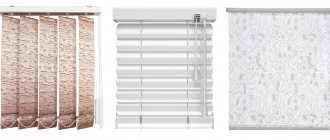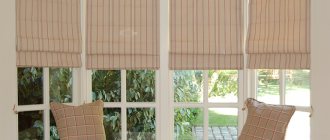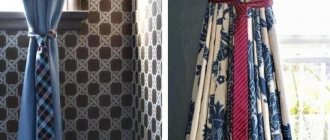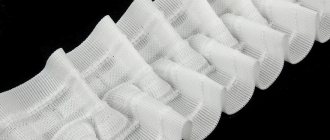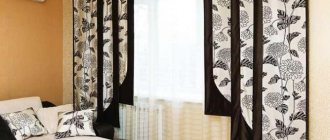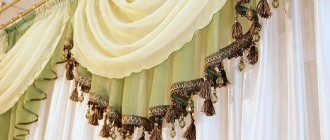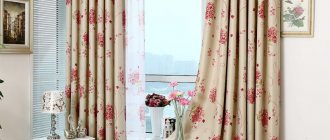Correctly selected curtains can complement any interior, regardless of the size of the room and its design style. But in order not to make a mistake with the choice of style, fabric and presentation of the models, you need to take into account the differences in modern products. First of all, you need to determine how long the curtains should be in different rooms. Our detailed explanations and indications of the pros and cons of different lengths of canvas will help you with this. After all, the same curtains in different interiors will look completely different. The possibility of using certain curtains must be determined based on their practicality and overall impact on the design of the room. It is necessary to calculate the optimal dimensions of the product. This will help you choose curtains that do not have to be hemmed or accurately take into account the fabric consumption for a specific model made to order. We explained in detail how modern products differ, and also indicated what curtains should be like in residential and non-residential rooms.
Types of curtains
There are many types of curtains, differing in style and design method. Commonly used options include:
- Classic
They are a smooth canvas with different lengths and a different number of waves (they can be completely straight). The upper part can be supplemented with lambrequins.
- Austrian
Curtains supplemented with laces to tighten individual parts of the fabric. Thanks to the non-standard design, the lower part of the models looks like several semicircles, consisting of numerous layers of stretched fabric.
- Roman
Just like the Austrian ones, they are supplemented with pull-up cords. But when lifted, they fold like an accordion.
- Rolled
A flat sheet used to cover a window. When lifted, such curtains are wound on a special roller.
- French
They are similar to the Austrian ones, but the tightened fabric waves on them are located not only at the bottom, but throughout the entire height.
- Italian
They resemble classic curtains, but they cannot be moved along the cornice: such models are fixed in one place. To open the window, they need to be moved towards the wall and secured on a hook or using a clamp.
- Japanese
They are a flat sheet (like roll sheets), fixed in separate strips. To open the window, the panels on the slats are moved in different directions.
- Cafe curtains
They may have the format of Austrian, classic or Roman curtains, but the curtain with them is not located in the upper part of the window (above the window), but in the middle of the window opening.
- Thread (muslin)
Curtains in the form of thin threads with or without lurex.
We take measurements
Naturally, the process of determining the optimal curtain sizes begins with taking the necessary measurements. So, the main data that we need to obtain is the width and length of the future curtains, and all other data, type of assembly, etc., are then calculated based on these data.
It is worth noting that measurements should be taken after the cornice has been selected and installed . Cornices come in different varieties and can be attached to the wall or ceiling, but in any case, the length of the cornice must exceed the width of the window. If this is a bedroom or other recreation room, then you can attach the cornice to the entire width of the walls, effectively emphasizing the window area. In other rooms, the cornice should be 20-30 cm larger than the window opening so that the curtains can move, making way for the sun's rays, the exception is the kitchen, where, as a rule, only a translucent curtain hangs, and the length of the cornice is almost the same as the width of the window . Please note that now there are curtain rods with adjustable length : if desired and necessary, they can be made a little shorter or longer.
It is advisable, of course, before taking measurements , to already decide on the model of curtains , since the calculation of the length and width of the required fabric will depend on the type of fabric, fastening, and number of layers of window decoration.
- The width of the curtains can be measured with a tape measure or soft measuring tape from the first fastening to the last .
- The length of the curtains is measured from the curtain rod or from the selected fastening elements, for example, rings, to the mark you need.
Classification of curtains by length/height and width
Depending on the length of the curtain and its width, the interior of the room where the curtains are used can vary significantly. Based on length, products are divided into the following categories:
- to the middle of the window;
- to the windowsill;
- below the windowsill;
- to the floor;
- to the floor and below the floor.
The width of the products also varies significantly. The model can cover only the window (glass and frame), or it can completely cover the window opening (including slopes). Modern curtains can partially cover the wall framing the window opening, as well as almost completely cover the wall with the window.
As for the specifics of choosing the length and width of the fabrics, first of all you need to take into account the tailoring style and functional requirements for the products. It is also important to remember about the different ways of installing different curtains: inside the window opening, on the frame, above the window opening, on the ceiling.
To the windowsill
Models up to the window sill also include products with a length up to the middle of the window. The latter usually have the form of an arch, allowing you to hide only the upper part of the window opening. Their advantage is to protect the room from sunlight during the day without interfering with the excellent access of natural light into the room. Curtains up to the window sill have a length that allows you to completely cover the glass and frame (possibly also the walls near the window opening). But at the same time they do not lie on the window sill itself. This option has many advantages. Short curtains are easier to care for (they can simply be removed and cleaned, regardless of style), and they unobtrusively complement the overall appearance of the room. They also do not interfere with easy access to plants or other objects located on the windowsill. They can be attached to the ceiling or wall, fixed above the window opening, mounted in the opening itself or on the frame.
Below the window sill
Curtains of this type can only slightly cover the window sill or go down 10-20 cm below it. These models look laconic in any interior. Well suited for bedrooms and children's rooms, as well as kitchens. To make opening a window with such products comfortable, it is recommended to install a couple of hooks on the walls on the sides of the window or prepare special grabs. The advantage of this type of model is the high-quality closure of the entire area of the window opening during the day and night. True, one cannot boast of a variety of styles suitable for such placement. Classic, Austrian, and French curtains are ideal for this arrangement. It is also worth considering that these models will be of little use for protruding window sills with significant depth.
To the floor
Curtains that reach the floor mean curtains that are located at a distance of 5-10 cm above the floor. They will be long enough to visually increase the height of the wall, but will not collect dust and debris below. Classic products, as well as Italian and Japanese models, are well suited for such placement. Floor-length threads placed in the bedroom of an adult or teenager will look unusual. Such threads will emphasize the originality of the stylization and bring dynamism to the interior. In spacious rooms with small window sills (so that the fabric in this area does not puff up), long French curtains can be placed. They will give the overall appearance of the room a special charm and elegance.
Curtains to the floor will help to beautifully hide the radiators. But in addition, it is recommended to install plastic, metal or wooden screens over the elements of the heating system.
To the floor and below the floor
The longest curtains that reach the floor or fall onto it are an excellent option for living rooms. They emphasize the individual taste of the owners and contribute to the unusual styling of the room. One of the most important advantages of such models is the visual increase in the height of the walls. In addition, when selecting a fabric that differs in color from the decoration, you can visually divide the room into several zones and beautifully highlight the window. The disadvantages of floor-length curtains include rapid contamination of the lower part of the canvas. Therefore, cleaning the rooms where such curtains will be hung must be carried out daily. Otherwise, it will simply not be possible to maintain the attractiveness of textiles. The following styles are considered ideal for such serving: Italian and classic.
Window curtains
Before taking on meters and centimeters, we must first determine for which room we are choosing a curtain. Of course, in any of them (whether it’s a bedroom, a children’s room, a kitchen or a living room), window curtains perform the same functions:
- protect from outside light;
- protected from views from the street;
- decorate or complement the interior and exterior of the house.
At the same time, the destination must be taken into account in order to choose the right material for curtains. For example, for a children's room and kitchen it is better to use smooth-textured synthetic fabrics - the material is not easily soiled and is easy to clean.
When selecting texture and color, a decorator, artist or interior designer may not be needed. Especially when the room has been furnished for a long time, and curtains are purchased to update its interior decoration.
It’s easy to learn the basic rules for selecting interior elements on your own. For example, the basic color principle states: fabrics of warm tones are selected for warm tones of wallpaper, artistically plastered or painted walls, and fabrics of cold tones are selected for cold ones. In particular, if the curtains are matched in color, but are 1 - 2 tones (on the color scale) darker than the wallpaper, they will bring a little more homely warmth and comfort to the room. It’s even better if the width of the curtains allows you to leave soft folds on their surface, even when the windows are completely closed.
Curtains of a color contrasting with the wallpaper visually reduce the space of the room. The same color as the wallpaper does not affect the visual perception of the cubic capacity and is suitable for small rooms. If you need to bring a wall with a window closer, then bright curtains in rich colors (preferably warm colors) will be successful. If you need to move it away, then you should select:
- lighter colors;
- cold tones.
When photo wallpaper or wall paintings are used in the room, or the walls are decorated in different colors, then the curtains should be selected to match the main background of the interior.
Technical nuance: Before calculating the length of the curtains, strengthen the curtain rod above the window. The optimal distance from the top edge of the window opening to the cornice is 7.5 - 12.5 cm. In order to effectively move the curtains apart and allow in or block out external light, the cornice strip should protrude 15 - 20 cm along the side edges of the window.
Curtain length depending on style
When choosing the desired length of curtains, one must not forget about the stylistic direction created in the room being furnished. After all, the length of the paintings will directly affect the perception of the interior. In addition, the same curtains (in the same style and from the same fabric), but with different lengths, will look completely different in a particular style. Our simple tip will help you choose the best solution for your home:
- short models (to the middle of the window, to the window sill);
Light colors will help add lightness to a classic or Provence design. Light grey, lilac or pastel colors will emphasize the comfort and restraint of styling (such options are optimal for modern and urban trends). Gray, white (possibly with black splashes) roller blinds or Roman blinds will complement modern, high-tech and Scandinavian style well. Canvases in bright colors will add dynamism to the design (but this option will only be appropriate in a teenager’s room, in the kitchen, or in a plain bathroom).
- medium models (below the window sill);
The “golden” mean, which will be appropriate in any direction. Thus, in a classic interior, curtains in dark colors will emphasize the solidity of the design. In loft and country, medium-length linen canvases will complement the simplicity of design. And in Provence, white or checkered canvases will be a good frame for any window.
- long models (to the floor, to the floor and below).
They highlight originality, elegance and sophistication of design. Linen fabric of this length can be used in loft design. Dark and neutral satin curtains are suitable for classic, urban style. Canvases with exquisite patterns, fringes and lambrequins will perfectly decorate Art Deco and Baroque.
Length of curtains in different rooms
The possibility of using a certain style and type of curtains in a particular room directly depends on the purpose of the room. The longest canvases can be hung on windows in the living rooms of adults and teenagers. In other rooms, their location will be irrational: frequent cleaning and fabric cleaning will be required. The average length of the curtains ensures ease of care, regardless of where they are placed. But at the same time, the variety of folds and the presence of complex weaving can lead to the problem of dust accumulation. Therefore, “standard” models made of natural or semi-synthetic fabrics in a simple design are recommended for kitchens and children’s rooms. As for short curtains, they are universal and suitable for any room. But at the same time, in a bedroom or living room, such models will not be able to emphasize all the individuality and originality of the decor. You also need to remember about the “match” of the room being furnished and the fabric used: they must be equal to each other in quality, direction, main external characteristics (refinement or simplicity, sophistication or “rough” presentation).
Curtains in the kitchen
A practical solution for the kitchen would be to choose short curtains (to the middle of the window or to the window sill) made of straight fabrics or with a minimum number of waves. Caring for such models will be easy and will provide good natural lighting to the room. Roll and classic short models can be considered optimal. These can be products made from medium-density fabric or light translucent fabrics. It is not recommended to choose a model with a protruding pattern or overly dense weaving for kitchens. Due to the nature of the room where cooking is carried out, it is in such cloths that dust and grease particles will constantly accumulate. And maintaining their attractive appearance will be quite difficult.
Day-night roller blinds can be a good solution for the kitchen. The presence of dense and translucent stripes will make it easy to adjust the brightness of natural light.
Curtains in the living room
Since the living room is intended for family recreation and receiving guests, in such a room you can hang both bright simple curtains and luxurious classic and Italian models. The choice should be directly based on the requirements of the owners and the atmosphere created in this room. So, in an elegant living room, Austrian and Italian floor-length models will look perfect. But in a bright modern living room, you can get by with short translucent curtains with bright patterns. Japanese models with a large pattern on each canvas will also look good. As for rooms with bay windows in which a sofa is located for relaxation, they can be decorated with curtains of any length. Such a corner will be well framed by both simple roller models and exquisite Austrian curtains.
Curtains in the bedroom
In a modern bedroom (as well as in modern and high-tech), short curtains will look good, which will only complement the interior of the room. For rooms decorated in light colors or with a non-standard design (Baroque, Art Deco, Provence), it is better to hang canvases to the floor or to the floor. It is not recommended to select curtains with numerous ruffles if the owners want to emphasize the simplicity of the design. And, conversely, to add luxury, fabrics with an original design, complemented by patterns and decorated with lambrequins, will become necessary. If you have a bay window or half bay window, you should take care of the ceiling placement of a semicircular cornice, which will help stylishly frame the window opening. Also, the highlight of the selected curtain in Provence or the classical direction can be a wooden lambrequin. True, it should be selected in the appropriate presentation: for Provence in a white color scheme, for classics in a more austere dark brown color.
Curtains in the nursery
In a children's room, curtains up to the window sill and just below the window sill would be appropriate. Long curtains cannot be considered a suitable option: if a child plays near the window, he may accidentally snag the product and, in the worst case, rip the curtain off the ledge. In children's rooms it is recommended to hang combined products: curtains with tulle. They will provide good protection of the room from the bright sun during the day (even if the child no longer sleeps during the day), and will prevent the penetration of light from lanterns and the moon into the room at night. Roll, French, and Austrian models can be considered the best options. Roman blinds or pleated curtains can also stylishly complement your baby’s room. True, it is better to clean multi-layer fabrics every day or every other day. This will maintain a healthy atmosphere in the room and prevent the accumulation of dust in the folds of the fabric.
Why do you need to make calculations?
The length should correspond to the type of room in which they will be hung. And the kitchen, living room, bedroom and children's room are completely different in their design and functionality.
And a lot will depend on the correct calculation: how the natural light source will act, how possible defects in the slopes and window sill will be hidden, how the interior of the room will be originally complemented, etc.
Tips for choosing fabric
You should choose a suitable fabric for sewing curtains or when purchasing finished products, taking into account all the characteristics of the material. These include density, appearance, ease of care. The following tip will help you easily and simply choose what kind of fabric you will hang in different rooms in your home:
- crepe: a synthetic fabric, usually complemented by bright, raised patterns, works well for simple styling;
- jacquard: dense fabric with patterned weaving, can be one-color or two-color, a good curtain option for the bedroom and living room;
- organza and chiffon: translucent fabrics that can become full-fledged curtains or used for sewing light curtains;
- satin and satin: silk fabrics with a shiny surface will emphasize the originality of the interior, but will require careful gentle cleaning;
- satin: a natural fabric with a loose weave that combines simplicity and conciseness;
- linen: a natural fabric with a coarse weave, ideal for simple, unpretentious window framing.
How to calculate the amount of fabric for curtains
Ordering curtains or sewing them yourself requires an accurate calculation of the required amount of fabric. For straight curtains without folds, you will need to measure the width and height of the window (or wall). But if you want to make curtains with folds, then you need to separately add the size of each assembly to the calculations made. Our simple table of coefficients will help you correctly calculate the required width of the fabric cut for curtains. The numbers indicated in it according to the number of folds or the type of fastening of the curtain must be multiplied by the previously measured width of the cornice (window). Additionally, add about 5-8 cm to the side fold of the fabric on both sides.
| Method of attaching curtains to the cornice/assembly features | Multiplication factor |
| On hinges | x 1.5 -2 |
| On the eyelets | x 2 |
| On the curtain tape | For plain fabric - x 1, for fabric with a pattern from x 1.5 to x 3 (depending on the frequency of pattern repetition) |
| With pencil folds | x 2-2.5 |
| With triple pleats | x 2-2.5 |
| With puffs | x 2.5 |
The length is determined as follows: the desired length of the curtain + 10 cm at the top and bottom for a neat tuck of the material.
The presence of a horizontal pattern requires consideration of its repetition. According to the width of the fabric itself in the roll and the distance between the patterns, it is necessary to determine the optimal length of the desired fabric.
We take into account all the details
The width of a roll of light fabrics (such as tulle, organza, veil) is usually 2 m 80 cm. If the height of the future curtain fits within these figures, then it is not difficult to calculate the number of linear meters required when purchasing.
The situation with curtain fabrics is more complicated - their rolls come in different widths: 1 m 40 cm, 2 m 80 cm, 3 m. In the case when the height of the curtain (in other words, its length) fits into the width of the roll, the footage is determined in the same way as indicated.
If the width of the roll is less than the length of the curtain, then the curtains will have to be sewn together from several pieces of fabric. In a financial sense, it is more burdensome. The number of canvases will also depend on the assembly coefficient and the pattern on the material. When connecting the canvases, the pattern must match - you will need additional centimeters to match the pattern.
If the curtains have a large print, then the number of meters purchased increases by the height of the repeat - a repeating pattern. And this applies to every panel. For example, both curtains have a total length of 5 m. The height of the repeat is 30 cm. We calculate how many meters of fabric will have to be purchased: 5 m + 30 cm + 30 cm = 5 m 60 cm.
Calculating the size of a curtain for a window seems difficult only at first glance. Difficulties disappear when you know how to do it.
How to take measurements correctly
Correctly taking measurements of the window opening, as well as the cornice to which the curtains will be attached, will help you correctly calculate the required footage of the finished product and not make a mistake when purchasing fabric. So, you need to measure the width as follows:
- For curtains that will frame only the frame and, accordingly, will be attached to the sash itself (roller, Roman): the width of the glass of each individual sash is measured. 2-3 cm are added to the resulting lengths.
- For curtains attached to a window opening or its middle: the width of the opening itself is measured.
- For curtains that will be attached to the curtain above the window opening or on the ceiling: opening width + 20-40 cm (depending on the requirements for partial or complete closing of the walls on the sides of the window).
As for measuring the height, it should be carried out from the point where the cornice is located. For example, for a cornice on the ceiling for floor-length curtains, this distance can be 280 or 300 cm (according to the ceiling height in the room). For floor-length canvases with a wall-mounted cornice, the height size can be 220 or 250 centimeters. Accordingly, for models up to the window sill, the length will be from 1.6 m or more.
Calculation of the number of cuts for curtains per window
A cut is a piece of fabric from which a curtain is made. Wide curtains can be sewn from six or even seven sections. If you are hanging a single narrow curtain from one piece, skip this part of the calculation.
To calculate the number of cuts, multiply the final width by the fullness of the curtain you need. Part of this depends on what type of top design you choose. It's not an exact science and the results will also depend on the fabric you choose and the impression you're trying to create. Multiply the final width by a factor appropriate to the type of top you choose. To calculate fabric for curtains, divide the resulting figure by the width of the fabric - usually 137 cm - to get the number of cuts you will need for each curtain. This number will need to be rounded up or down to the nearest value equal to half the width of the fabric.
Below we tell you how to correctly calculate the final length of curtains.
How to choose the color of the canvas and what to combine it with
The selected curtains can complement the selected color scheme of the room or become a bright frame for the window, highlighting it from the general background. The simplest options for selecting the desired color of the canvas include the following schemes:
- By tone of finish
Products must have a similar shade to the chosen finish. In some cases, it would be appropriate to have a curtain color identical to the color of the finish.
- According to the tone of the furniture
Quite often, the identical color of curtains and furniture allows you to get a stylish and beautiful room design.
- By textile tone
The same colors of sofa cushions, carpet and curtains will help create beautiful accents in the overall design.
- Selecting a balcony area or recreation area
For this scheme, curtains and a pair of armchairs (or a small sofa) in the same color are selected. Upholstered furniture will be located in front of the window, on the balcony or in the opposite corner of the room.
- Selecting a window opening
This option is suitable for bright rooms. The selected curtains will act as a bright accent, drawing the eye specifically to the window. It would be logical to decorate the window sill with live plants, discreet pillows or other decor.
Calculation example
When all the necessary measurements have been taken, it is time to calculate the width and length of the curtains or fabric for them. If the resulting width of the window area is 2 m and the length is 2.7 m, and you need to purchase curtains and drapes, then you can safely use the assembly factor (KS) = 2 and then we find that the width should be 4 m for a given length.
If you want the window to be decorated with original and unique curtains that are not available in the store, then you need to buy the required amount of fabric to sew them . So, how much fabric will be needed for curtains and drapes for our conditional window?
The standard width of a roll of translucent tulle is 2.8 m , which should be quite enough for the standard window height, so the length issue remains resolved. As for the width, given the width of the window and the selected frame, you will need 2 * 2 = 4 m of fabric. But since the allowances on the sides are 5 cm, the total amount of fabric will be 4.1 m.
The width of curtain fabric is usually 1.4, 2.8 or 3.0 meters. It’s good if the width of the canvas ideally matches the length of the window opening, but it may be that the width is not enough, and then you will have to measure the fabric lengthwise and use several canvases to cover the window opening. Here it is important not to forget about the combination of the pattern and the length of the repeat - a repeating element of the ornament. In this case, you can sew a special fabric together, or maybe just make curtains from two parts.
The calculation in this case will be like this:
amount of fabric = ((window opening height + allowance)*number of panels) + repeat * (number of panels – 1)
If the window width is 2 m and KS = 2, and the width of the fabric in the roll is 1.4 m, then to make curtains, for example, you will need 3 canvases: 1.4 * 3 = 4.2 m, with a repeat value of 0.35 m we get the following data:
amount of fabric = ((2.7+0.2)*3)+0.35*2=9.4 m
If after cutting the fabric and sewing the curtains there is a lot of fabric left , and this may be when a large pattern was chosen, then from the remnants it will be possible to sew tiebacks for curtains or small pillows for the sofa. When the curtains and other textiles in the room are made in the same style, this gives a special effect to the room.
It’s easy to sew the most common curtain models yourself, but if you doubt your professionalism or are planning to decorate a window with an elaborate model, then it is better to resort to the services of specialists.


